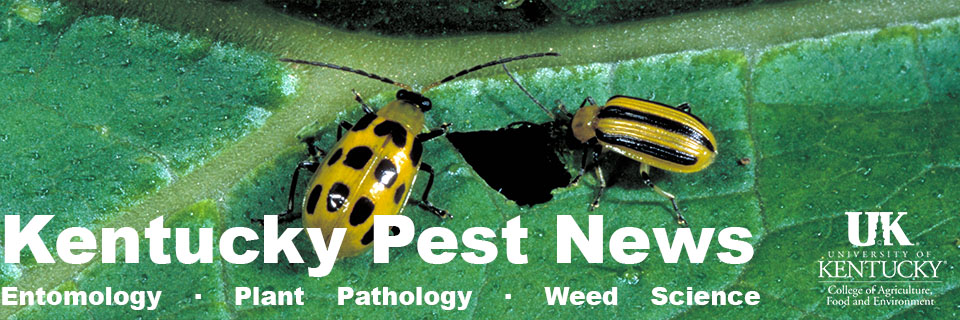Sugarcane Aphid Identification
The sugarcane aphid (Melanaphis sacchari) is an invasive pest that may rapidly produce population outbreaks and cause heavy yield reductions in grain and sweet sorghum. Sugarcane aphids are easily identified under a dissecting microscope; they are recognized by their grey to tan yellow body color, their dark cornicles or “tailpipes,” as well as their dark feet and antennae (Figure 1). Besides the sugarcane aphid, several species of aphids can be found on sorghum, such as the corn leaf aphid (Rhopalosiphum maidis), the yellow sugarcane aphid (Sipha flava), and the greenbug aphid (Schizaphis graminum). They are hard to distinguish from one another with the naked eye, but they are identifiable with hand-held magnification lenses (Figure 1).

Figure 1. Species of aphids found in sweet and grain sorghun. The sugarcane aphid can be identified by the dark cornicles compared to the green bug or yellow sugarcane aphid. (Photo: USDA)
Registered Insecticides
The Environmental Protection Agency (EPA) granted permits for the registration of two insecticides against the sugarcane aphid in Kentucky this month. Transform™ WG (sulfoxaflor, Dow AgroSciences) and Sivanto™ prime (flupyradifurone, Bayer) are registered for grain and sweet sorghum, respectively. This is great news for grain and sweet sorghum growers of Kentucky. The permits have arrived just after several reports of the presence of the sugarcane aphid in several counties of Kentucky (KPN). Labels of these two insecticides can be downloaded from here.
Growers should note:
Although grain sorghum and sweet sorghum are the same plant species, the insecticides registered, their rates, and their uses may differ. Transform™ WG is not registered for use on sweet sorghum (see Table 1). Also, all growers will need a Private Applicators License to make that crisis exempt application.

Table 1. Foliar application restrictions for Sivanto™ prime and Transform™ WG on grain and sweet sorghum (click on table to enlarge).
Insecticides Registered for Grain Sorghum
The insecticides Transform™ WG (registered on July 18, 2016 under Section 18) or Sivanto™ Prime (flupyradifurone, Bayer) should be considered if sugarcane aphids are found with numbers exceeding the threshold of 30 to 120 aphids per leaf (a threshold established by researchers of Texas A&M University and Louisiana State University). Sivanto Prime was previously registered for its use in grain sorghum under FIFRA’s Section 24(c). These insecticides are effective; however, abundant water should be used for a good coverage.
The foliar application rates and restrictions for Transform™ WG, and Sivanto™ prime are shown in Table 1. The most common application rate on grain sorghum for Transform™ WG is 1 oz/A; and 4 to 5 ounces of Sivanto™ prime when populations are close to the threshold levels of 30 to 120 sugarcane aphids per leaf at pre-boot or dough stage. If sugarcane aphid populations exceed the upper levels of the threshold, the higher rates of these insecticides are justified and should be used. Kansas State University provides different threshold levels based on the growths stage of the plant (here). This is shown in Table 2.

Table 2. Threshold levels for sugarcane aphid based on the percentages of plants infested, honeydew levels, and the growth stage of the plant (click on table to enlarge)
Insecticide Registered for Sweet Sorghum
The insecticide Sivanto™ Prime is the only insecticide available for sweet sorghum. It was registered under section 18 crisis exemption in Kentucky on July 25, 2016. The application rates for Sivanto™ prime are from 4.0 to 10.5 oz/A; a total of 28.0 oz of Sivanto™ prime per acre per year. In addition, label restrictions state: no more than four applications per year, a preharvest interval of 7 days, a minimal interval between applications of 7 days, and a re-entry interval of 4 hours. Although there are not sugarcane aphid thresholds established for sweet sorghum, the threshold established for grain sorghum mentioned above will be used for sweet sorghum until data are collected to establish these levels.
Scouting for Sugarcane Aphids
It is recommended that growers or consultants check one upper leaf (a leaf below the flag leaf), and one lower leaf (the 3rd or 4th green leaf from the ground) per plant from 10 randomly plants taken within a 50 foot row stretch of plants. Repeat this on 4 different sites of a field, and if the averages of all the leaves are above or near the threshold mentioned above, an application of any of these products should be considered.
By Raul T. Villanueva, Lee Townsend, and Ric Bessin, Extension Entomologists
